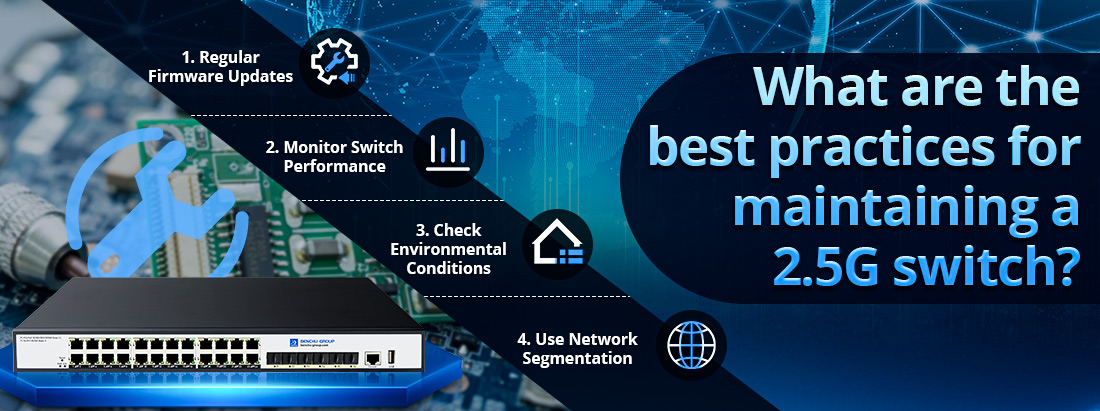
Maintaining a 2.5G switch properly is crucial for ensuring long-term performance, reliability, and stability in your network. By following best practices, you can minimize downtime, prevent issues, and extend the life of the device. Below is a detailed description of best practices for maintaining a 2.5G switch:
1. Regular Firmware Updates
Importance: Firmware updates provide performance improvements, security patches, and new features. Manufacturers often release updates to address bugs, vulnerabilities, and compatibility with new protocols or devices.
Best Practice: Periodically check for firmware updates from the manufacturer and apply them as needed. Before updating, backup the switch's configuration and ensure the update process is carried out during non-peak hours to avoid network disruption.
Automated Checks: Some managed switches allow for automated firmware checking, which can alert you when an update is available.
2. Monitor Switch Performance
Importance: Proactive monitoring helps identify potential issues before they affect network performance. Overloaded ports, high CPU or memory usage, or network errors can indicate problems.
Best Practice: Use the switch’s built-in monitoring tools or third-party network management software to regularly monitor performance metrics such as:
--- Port Utilization
--- Bandwidth Usage
--- Error Rates
--- Temperature Levels
Thresholds & Alerts: Set thresholds for key performance indicators (KPIs) and enable alerts to notify administrators when a metric exceeds its normal range. This can help catch early signs of hardware failure or network congestion.
3. Check Environmental Conditions
Importance: Environmental factors such as temperature, humidity, and dust can affect a switch’s lifespan and performance.
Best Practice:
--- Temperature: Ensure the switch is installed in a well-ventilated area with a temperature-controlled environment (generally between 32°F to 104°F or 0°C to 40°C).
--- Humidity: Maintain relative humidity levels within the recommended range (usually 10% to 90%, non-condensing).
--- Dust Protection: Clean dust filters regularly and avoid placing switches in areas with excessive dust. Dust can block airflow and cause overheating.
Cooling and Ventilation: Make sure the switch’s vents or cooling fans are not obstructed. For larger installations, consider rack-mounting the switch with proper airflow management to prevent overheating.
4. Backup Configurations Regularly
Importance: Configuration backups ensure that your network can be quickly restored in case of hardware failure or misconfiguration.
Best Practice: Regularly backup the switch’s configuration, especially after making changes to VLANs, access control lists (ACLs), or Quality of Service (QoS) settings. Store backups securely, and consider keeping both local and remote copies.
Automated Backup: For larger or more complex setups, use automation tools to perform periodic backups without manual intervention.
5. Use Network Segmentation
Importance: Segmentation helps improve performance, security, and fault tolerance by separating different types of traffic, such as voice, video, and data.
Best Practice: Use VLANs (Virtual Local Area Networks) to segment the network effectively. For example, keep surveillance cameras, VoIP systems, and office workstations on different VLANs to ensure traffic does not compete for the same bandwidth.
Traffic Prioritization: Implement QoS to ensure critical applications like video conferencing or VoIP receive priority, especially during times of high traffic.
6. Monitor Power Supply and Use Redundancy
Importance: Switches can fail due to power interruptions, surges, or instability in the power supply.
Best Practice:
--- Use an Uninterruptible Power Supply (UPS): For mission-critical switches, connect them to a UPS to prevent sudden shutdowns due to power outages. This ensures network continuity and protects the switch’s hardware.
--- Power Redundancy: Some switches support dual power supplies. If available, utilize both to add redundancy and improve reliability.
--- Surge Protection: Make sure that switches are protected from electrical surges with appropriate surge protectors.
7. Port Maintenance and Cable Management
Importance: Poor cable management can lead to physical damage to switch ports and increased wear over time. Damaged or improperly connected cables can cause connectivity issues or packet loss.
Best Practice:
--- Cable Management: Use cable organizers, trays, or Velcro ties to keep cables tidy. This reduces strain on switch ports and makes troubleshooting easier.
--- Check and Replace Faulty Cables: Periodically inspect Ethernet cables for damage, especially if experiencing connection issues. Faulty or old cables can degrade network performance.
--- Use the Right Cable Type: Ensure you're using CAT5e or CAT6 cables for 2.5G Ethernet to get the full performance benefits. Label cables for easier identification.
8. Security Measures
Importance: Security vulnerabilities can lead to unauthorized access, data breaches, and compromised network integrity.
Best Practice:
--- Secure Access Control: Limit administrative access to the switch using strong passwords and, if supported, multi-factor authentication (MFA).
--- SSH Over Telnet: Use SSH instead of Telnet for remote management to ensure encrypted communication.
--- Network Monitoring and Intrusion Detection: Set up Intrusion Detection Systems (IDS) and monitor logs for unusual activity, such as unauthorized access attempts or traffic spikes.
--- Port Security: Enable port security features to limit the number of devices that can connect to each port, reducing the risk of unauthorized devices connecting to your network.
9. Scheduled Reboots
Importance: Switches often run continuously for years, which can lead to memory leaks or performance degradation over time.
Best Practice: Perform scheduled reboots during maintenance windows to refresh the switch’s system and clear any potential memory issues or processes that might have stalled. This can help maintain long-term stability.
10. Audit Logs and Reporting
Importance: Keeping track of network events helps in troubleshooting issues and understanding network behavior over time.
Best Practice: Enable and regularly review event logs and system reporting on the switch. Logs can provide insights into potential issues like port errors, bandwidth bottlenecks, or unauthorized access attempts. Set up alerts for critical events to ensure immediate action when needed.
Conclusion:
Maintaining a 2.5G switch involves a combination of firmware updates, performance monitoring, environmental control, and security best practices. Regular backups, proper power management, and proactive network monitoring help ensure your switch remains reliable, efficient, and secure. Implementing these best practices ensures long-term stability, optimal performance, and the ability to respond quickly to any potential issues.